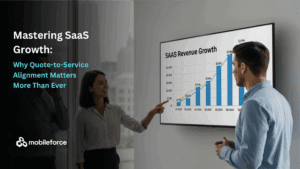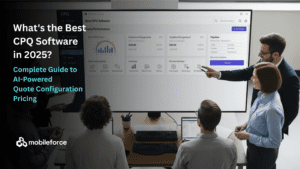
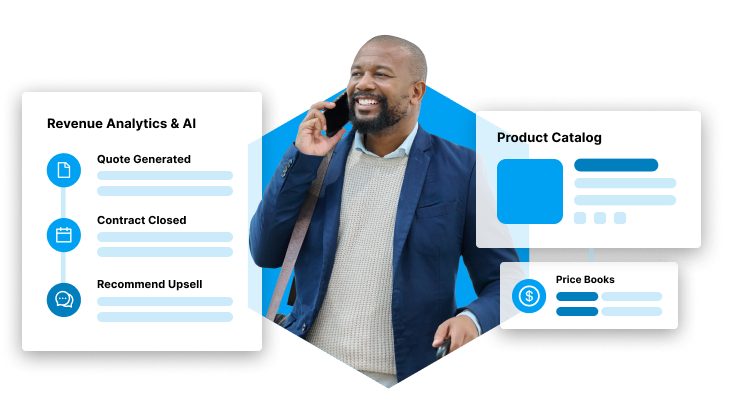
Mobileforce
- General Resources
Table of Contents
ToggleIntroduction: Big Shifts in the CPQ Market
You’ve likely heard the news. Salesforce has officially moved its CPQ product into End-of-Sale (EOS) mode. That means Salesforce will not bring on any new customers to its legacy $1 billion/year onetime Steelbrick CPQ solution. There’s also been no significant updates to their legacy solution in more than three years and an unclear roadmap going forward.
For Salesforce CPQ Admins and RevOps leaders, these developments raise urgent questions: What’s next? Is Salesforce Revenue Cloud CPQ the answer? Should we wait, migrate, or move on? And above all, how can we future-proof our quoting processes amid so much uncertainty?
After years of helping hundreds of companies scale revenue through CPQ, we know what works—and what doesn’t. This post is the first in a new series aimed at helping you cut through the noise and take control of your CPQ strategy.

What Salesforce CPQ End-of-Sale Actually Means
Let’s be clear: End-of-Sale is not the same as End-of-Life. Existing customers can continue to use Salesforce CPQ and receive support—for now. But the writing is on the wall. With no updates in years, no public roadmap, and a full pivot toward Salesforce Revenue Cloud, it’s clear that Salesforce is winding down its current CPQ offering.
Salesforce Revenue Cloud CPQ is being positioned as the future. On paper, it sounds promising: a native, modern CPQ built on Salesforce’s core platform. But here’s what you need to know:
- It is not yet ready for complex quoting environments. Most users will need to wait for multiple future releases before it becomes fully functional.
- There is no direct upgrade or migration path. Companies must reimplement their quoting setup from scratch.
- It introduces higher implementation and maintenance complexity, especially compared to the existing SteelBrick package.
- Pricing is based on a consumption model, with per-user fees and event-based billing that can increase total cost of ownership.
- The ecosystem of trained implementation partners is still maturing, so onboarding help is limited.
If you’re relying on Salesforce CPQ today, you’re facing a decision point.
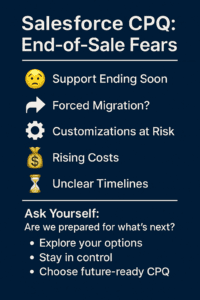
Real Concerns for CPQ Admins and RevOps Leaders
This transition is creating deep concern across teams:
For CPQ Admins:
- What happens to existing workflows, logic, and customizations?
- Will Salesforce continue supporting bug fixes and enhancements?
- How steep will the learning curve be for a completely new platform?
For RevOps Leaders:
- Should we transition to Salesforce Revenue Cloud CPQ or consider third-party solutions?
- What’s the real cost and timeline to reimplement our quoting system?
- Are we risking business continuity if we delay a decision?
- Can we realistically expect support or expertise from Salesforce partners?
These are not just technical decisions—they impact how fast you can respond to deals, how accurate your quotes are, and how smoothly sales operations run.
CPQ for Your Needs—Today and Tomorrow
CPQ isn’t just about creating a quote. It’s about supporting a scalable revenue engine that can flex with your business. To do that well, you need to:
- Solve today’s quoting challenges while planning for future growth
- Choose a vendor with proven expertise in CPQ, not just a bundled add-on
- Rely on a platform with an active product roadmap and real investment
- Ensure the solution integrates with your broader tech stack
Making the wrong choice leads to friction, low adoption, and wasted resources.
CPQ is a long-game decision. Choose a partner, not just a platform.
Turning Uncertainty into Opportunity
This moment of transition can be the perfect time to assess your quoting environment. Are any of these true for you?
- Quoting is slower than it should be
- Reps avoid using the CPQ tool altogether
- Mobile access is lacking or clunky
- Your approval process is manual and filled with bottlenecks
- Admins spend too much time maintaining rules and templates
If so, it’s time to look at solutions that offer both immediate and long-term gains.
How Mobileforce is Helping Companies Navigate the CPQ Crossroads
Mobileforce is not just another CPQ vendor. It is purpose-built to help companies adapt quickly, simplify quoting, and support a connected revenue lifecycle.
Here’s what makes Mobileforce unique:
- No-code/low-code architecture: Configure rules, approvals, workflows, and quote templates without writing code. You can respond to new pricing models, product bundles, or go-to-market motions quickly.
- Seamless quote-to-cash-to-service: Manage the full customer lifecycle from first quote to onboarding to long-term service. This is ideal for service-oriented and subscription-based businesses.
- Seller-centric design: The platform mirrors how salespeople actually sell, improving adoption, reducing friction, and speeding up quote creation.
- Real-time data integration: Connect with ERP, inventory, or policy systems to ensure quotes are always accurate and up-to-date.
- Offline capabilities: Sales reps can generate and manage quotes even without internet access—perfect for field reps, remote locations, or areas with unreliable connectivity.
- Simplified approvals: Integrated, rule-driven approval workflows help speed up deal cycles and reduce delays in complex sales environments.
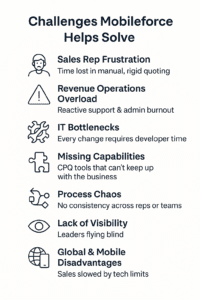
Challenges Mobileforce Helps You Solve
Mobileforce is built to eliminate the friction that persists across sales quoting processes, even after significant investments in CPQ systems. Sales teams remain bogged down by manual, time-consuming tasks; RevOps can be overwhelmed with constant support demands and administrative burdens; and IT often struggles with rigid, inflexible tools that can’t keep up with evolving business needs. Mobileforce tackles these challenges at their core—reimagining quoting as a flexible, intelligent, and outcome-driven process that accelerates performance across Sales, RevOps and IT.
1. Sales Rep Frustration: Time Lost in Manual, Rigid Quoting
Sales reps are often stuck navigating outdated CPQ tools that make simple changes time-consuming and error-prone. Instead of focusing on selling, they get pulled into the weeds—toggling between product catalogs, struggling with multi-term configurations, and chasing down approvals for minor edits. This leads to deal delays, frustration, and even lost opportunities.
How Mobileforce Helps:
- Single quote support for multiple subscription terms and ship-to addresses eliminates the need to create duplicate quotes for each variation.
- Flexible amendments allow reps to update quantities or dates without removing and re-adding products.
- A built-in line item trash can makes it easy to clean up mistakes without starting from scratch.
- Co-terming logic automates contract alignment, reducing quoting complexity.
- Offline quoting empowers field reps to create, edit, and approve quotes anywhere—even at events or remote sites.
Result: Mobileforce slashes the time reps spend on quoting by up to 25%, helping them stay in front of customers—not stuck in a CPQ tool.
2. Revenue Operations Overload: Reactive Support & Admin Burnout
RevOps is the unsung hero behind every quote, but often their time is spent answering tickets, updating price books manually, and fixing mistakes reps shouldn’t be making in the first place. They act as a safety net for broken workflows—constantly firefighting instead of optimizing.
How Mobileforce Helps:
- Auto-discount calculation based on available budget or total percentage eliminates spreadsheet work.
- Mass pricing updates across the catalog can be executed in one click—no more SKU-by-SKU edits.
- Price book localization converts USD values to local currencies for international teams, reducing RevOps burden.
- Tag-based special pricing replaces SKU-level complexity with a more scalable logic model.
- One-click renewals simplify contract extensions without reconfiguration.
Result: RevOps becomes proactive and strategic again—reducing ad hoc support and gaining back over 25% of their time.
3. IT Bottlenecks: Every Change Requires Developer Time
IT teams are often the gatekeepers of CPQ logic—but when every update requires development or admin effort, scaling becomes unsustainable. Whether it’s adding a new product line, changing approval logic, or exposing CPQ to partner channels, IT becomes a bottleneck in the sales process.
How Mobileforce Helps:
- Offers a low-code/no-code configuration panel, so catalog changes, rules, and flows can be updated without code.
- Provides headless quoting via API, allowing channel partners or external platforms to generate valid quotes seamlessly.
- Supports role-based user interfaces—tailored layouts for SDRs, AEs, partners, and finance teams—reducing maintenance complexity.
- Integrates natively with CRM, ERP, billing, and provisioning systems, eliminating data silos and reducing middleware overhead.
Result: IT scales quoting without scaling workload—supporting agile go-to-market moves without delays.
4. Missing Capabilities: CPQ Tools That Can’t Keep Up with the Business
Many legacy CPQ platforms simply weren’t built for today’s SaaS and cloud-first selling models. When businesses need to quote usage-based pricing, hybrid deals, or cloud burn-down models, they often hit technical limits. Workarounds become the norm, leading to inefficiencies and risk.
How Mobileforce Helps:
- Multi-term quoting allows different product start/end dates on a single quote—ideal for phased rollouts.
- Supports credit burn-down models, letting companies track consumption of prepaid services or cloud credits.
- One-click renewals reduce the time and errors in subscription extensions.
- Adapts to consumption-based billing logic, aligning with modern pricing strategies.
Result: Organizations can quote the way they actually sell—without technical compromises or endless customization.
5. Process Chaos: No Consistency Across Reps or Teams
Without standardization, quoting becomes a free-for-all. Some reps follow policy, others don’t. Some use pricing rules, others go rogue. This leads to compliance violations, revenue leakage, and unpredictable customer experiences—especially when new reps are onboarded.
How Mobileforce Helps:
- Delivers guided selling paths that walk reps through product selection, pricing logic, and contract terms based on deal type.
- Enforces business logic through template-driven workflows that include approval rules, discount ceilings, and co-term constraints.
- Ensures multi-tiered approval flows with escalation paths are followed every time, not skipped or forgotten.
Result: Every rep follows the same process. Every quote follows the same rules. No more wildcards.
6. Lack of Visibility: Leaders Flying Blind
When leadership lacks visibility into quoting trends, approval delays, and discount patterns, it’s impossible to optimize performance. Most CPQ tools don’t offer real-time reporting or drill-down analytics—creating blind spots that cost time and revenue.
How Mobileforce Helps:
- Tracks quote creation time, helping sales ops identify slowdowns and stuck deals.
- Measures approval cycle length and surfaces where escalations are frequently needed.
- Provides dashboards for discount usage, exception reporting, and consumption tracking, so nothing falls through the cracks.
- Supports drill-down insights into quoting activity by rep, region, product, or account.
Result: Leaders get actionable data—not just reports—enabling them to improve efficiency, compliance, and forecast accuracy.
7. Global & Mobile Disadvantages: Sales Slowed by Tech Limits
In many organizations, reps work in the field, across time zones, or in places with poor connectivity. Most CPQ systems aren’t designed for offline use, mobile responsiveness, or real-time synchronization—leading to missed quotes and delayed deals.
How Mobileforce Helps:
- Enables offline quoting, allowing reps to build and save quotes without internet access; data syncs automatically once reconnected.
- Works across all devices—mobile, tablet, desktop—so reps can quote from anywhere.
- Automatically handles currency localization and regional pricing, supporting global teams without complexity.
Result: Sales doesn’t stop just because a rep leaves the office. Mobileforce keeps the quoting engine running from anywhere.
To sum it up, whether it’s the rep quoting in the field, the RevOps manager optimizing workflows, or the IT team scaling infrastructure, Mobileforce enables every team to move faster with confidence. Compared to traditional CPQ systems, customers experience up to 140% better performance—in speed, usability, and business outcomes.
What to Look for in a CPQ Platform
Choosing the right CPQ platform isn’t just about functionality—it’s about long-term business alignment. Here are key considerations to guide your evaluation:
- Understand your current state: Before evaluating platforms, map out your existing quoting workflows, pain points, and business goals.
- Focus on user adoption: Your CPQ should be intuitive for sellers. If they don’t use it, it won’t matter how powerful it is.
- Prioritize speed and accuracy: Every extra minute spent building a quote adds friction. Seek a system that enables rapid, error-free quoting.
- Ensure deep integration capabilities: Look for a platform that easily connects with your CRM, ERP, inventory, and support tools. This prevents silos and enhances operational efficiency.
- Look for scalability: Choose a CPQ that grows with your business. It should handle increasing deal volume, user count, and product catalog complexity.
- Evaluate vendor support and ecosystem: Assess the maturity and responsiveness of support, onboarding resources, and implementation partners.
- Check roadmap and innovation commitment: You need a platform that evolves with market needs, not one that stagnates.
- Consider offline functionality: If your sales teams operate in the field or globally, offline support can be a dealmaker for productivity and business continuity.
- Look for compliance support: Ensure your CPQ can enforce pricing and discounting policies, approvals, and documentation workflows.
The best CPQ platforms serve as a force multiplier for sales, not a bottleneck.
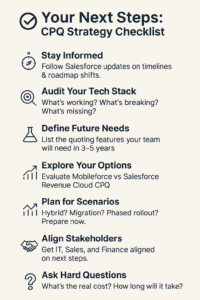
Your Next Steps: A Strategic Checklist
- Stay Informed: Follow Salesforce communications on CPQ timelines and changes
- Audit Your Tech Stack: Identify what’s working, what’s breaking, and what’s missing
- Define Future Needs: Outline key quoting capabilities you’ll need over the next 3–5 years
- Explore Your Options: Evaluate Mobileforce alongside Salesforce Revenue Cloud CPQ
- Plan Scenarios: Consider a hybrid approach, full migration, or phased rollout
- Align Stakeholders: Ensure IT, Sales, and Finance are in lockstep
- Ask Hard Questions: What are the total costs? What does implementation actually look like?
Conclusion: Own Your CPQ Future
Salesforce CPQ’s end-of-sale is official, and their alternative isn’t ready for every business. Plus, quote-to-cash is far too critical to leave uncertain.
Now is the time to assess, act, and advance. With Mobileforce, you get a quoting solution designed for sellers, built for speed, and ready to scale.
Why Mobileforce: Whether you stay with Salesforce for now, explore a parallel path, or go all-in on change, Mobileforce helps can help your company reduce risk, improve workflows, and deliver faster, more accurate quotes. Questions? We’ve got answers: contact us here for more info or a free demo.
CTA:
